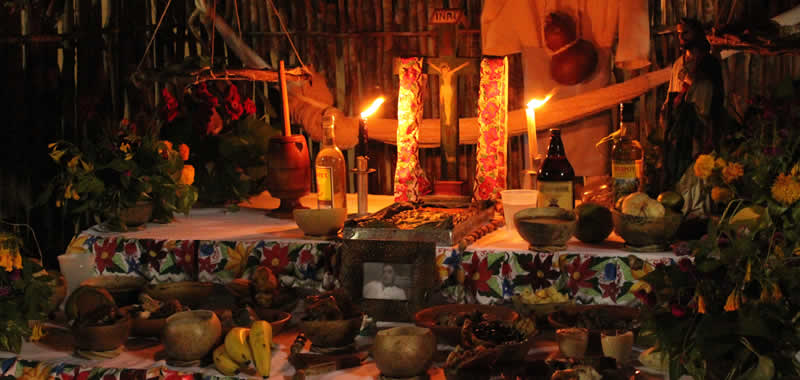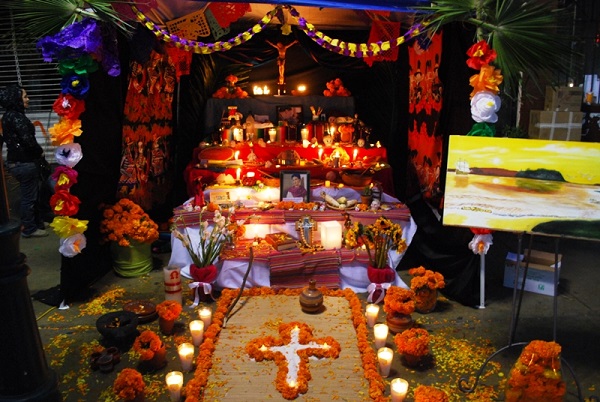This custom has its origin in the ancient Mayan rituals to present their respects to their dead, and those rituals were mixed with the Catholic beliefs that the Spanish brought to Mexico five hundred years ago…
Everybody knows that “Día de Muertos” is one of the most important Mexican traditions, but what not everybody knows is that, it has special characteristics depending on the state where it is celebrated. That is why TYT brings you today a general explanation on the Yucatecan “Dia de Muertos”: the “Hanal Pixán”.
The name Hanal Pixán means “food for the spirits”; it comes from two Mayan words, Hanal that means Food and Pixán that means Spirits/Souls. It is celebrated from October 31st to November 2nd. During those three days the Yucatecans present their respects to all the people that have passed away: relatives or friends, anybody who isn’t anymore among us has a space on their loved ones’ altar.
According to Mexican tradition, in those three days the souls of the dead come to our world to have a meal with their relatives. That’s why we, the living ones, must put an altar with food and beverages to offer to these spirits.
The first day, October 31st, is dedicated to the kids and is called in Mayan language “U Hanal Palal”. The second day, November 1st, is for the adults and its name in Mayan language is “U Hanal Nucuch Uinicoob.” And the third day is called “U Hanal Pixanoob,” and is dedicated for all the dead in general. The food and decoration on the altar should change depending on the day; also one altar could be dedicated to many deceased people.
The altar decorations change depending on if it is dedicated to kids or adults; in the first case it should have color candles, tablecloth and paper decorations, and also should include many candies and toys that the kid liked when he/she was alive. In the case of adults the candles and the tablecloth must be white, the paper decorations could be white and black and the food must be according the preferences of the dead to whom is dedicated the altar; many people include beer, liquor and cigarettes.
Never forget to place on the altar the photograph of the person or persons to whom it is dedicated, some religious objects like a Virgin Mary figure and a crucifix, also the cempasuchil flowers and incense, the Pib o mucbipollo (which is the most important meal on the altar), papaya and pepita candies, atole and fruits like jícamas, tangerines and oranges.
The Altar is the principal element in this celebration because it is the place where the deceased souls meet with the living ones and keep alive the memory of the ones that have passed away.
Now, after reading this, the TYT team invites you to participate in this amazing celebration full of traditions and flavors;. Keep having a good fall season!
By Jorge Andrés Barrera Rojas for TYT
With an International Trade degree from the Autonomous University of Yucatan, Jorge is currently an Editor for The Yucatan Times, Business Adviser and Chinese language and culture student. He also speaks Spanish, English and French.
To check the rest of the “Dia de Muertos” series click on the tag “Dia de Muertos” or on the following links:
- www.theyucatantimes.com/dia-de-muertos-all-saints-day-two-schools-of-thought-blend-into-one-tradition/
- www.theyucatantimes.com/the-four-most-haunted-places-in-yucatan/
- www.theyucatantimes.com/dia-de-muertos-a-celebration-of-life/
- www.theyucatantimes.com/la-catrina-mexican-representation-of-death/
- www.theyucatantimes.com/meridas-general-cemetery-the-gate-to-the-other-life/
- www.theyucatantimes.com/the-paseo-de-las-animas-meridas-new-tradition/
- www.theyucatantimes.com/pan-de-muerto-the-sweet-part-of-the-dia-de-muertos-festivity/
- www.theyucatantimes.com/tyt-infographic-dia-de-muertos/







